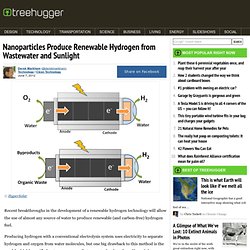

Storing green electricity as natural gas. Renewable electricity can be transformed into a substitute for natural gas.

Until now, electricity was generated from gas. Now, a German-Austrian cooperation wants to go in the opposite direction. In the future, these researchers and entrepreneurs would like to store surplus electricity -- such as from wind power or solar energy -- as climate-neutral methane, and store it in existing gas storage facilities and the natural gas network. Throughout the world, electricity generation is based more and more on wind and solar energy. So far, the missing link for integrating renewable energy into the electricity supply is a smart power storage concept. For the first time, the process of natural gas production combines the technology for hydrogen-electrolysis with methanisation.
News Blog: Algaeus lives! A modified Prius goes cross-country on fuel from algae. Algae Street Lamps. Sunday, 08 April 2012 GreenMuze Staff Algae Lamps from Shamengo.

French biochemist Pierre Calleja has created large-scale algae powered street lamps that can potentially absorb more than one ton of CO2 a year. Algae lamps can charge up batteries during the day through their photosynthesis process that is driven by the sun and nutrients. This stored power is then used at night to power lights. Calleja’s lamps can also be illuminated artificially, such as in dark underground parking lots, where the algae go to work absorbing all the CO2 emissions from the cars. Maybe a forest of these algae lamps in every city might go a long way to replace all the CO2 absorbing trees that got cut down to make way for urban sprawl.
<div style="background-color:red;color:white;width:160px"><strong>JavaScript is disabled! Adobe Flash Player not installed or older than 9.0.115! Via Shamengo. New Method of Turning Sewage Sludge into Biodiesel is Low-Cost, High-Yield. © ACSI have a love/hate affair with biofuels and biodiesel, because while they may be cleaner than petro-fuels, and considered a renewable resource, growing the feedstock usually entails a lot of land and a lot of water, both of which are limited resources.

But if a new process for making biodiesel from sewage sludge gets commercialized, every flush of the toilet could be helping to fuel some of our energy needs. A team of researchers in South Korea have developed a new process for converting the lipids in sewage sludge into biodiesel, at not only a lower cost than conventional biodiesel, but with much higher yields. The team, working out of the Research Institute of Industrial Science and Technology, found that the sewage sludge produced 2,200 times more lipids per gram than soybeans, and at a much lower cost. Nanoparticles Produce Renewable Hydrogen from Wastewater and Sunlight. © HyperSolarRecent breakthroughs in the development of a renewable hydrogen technology will allow the use of almost any source of water to produce renewable (and carbon-free) hydrogen fuel.

Producing hydrogen with a conventional electrolysis system uses electricity to separate hydrogen and oxygen from water molecules, but one big drawback to this method is the need for highly purified water as a source. Electricity generated from water: Major breakthrough in clean Free Energy confirmed. BlackLight Power, Inc.

(BLP) announced last week a major breakthrough in clean energy technology, which experts agree holds tremendous promise for a wide range of commercial applications. Bloom Energy Solid Oxide Fuel Cells. Open Source Biodiesel Tutorial. Plasma Gasification Transforms Garbage into Clean Energy. It sounds too good to be true: a machine that can get rid of almost any kind of waste at a fraction of the cost of today's disposal techniques, eliminate existing landfills, and produce an excess of clean energy to be sold back to the grid. This very realistic process is called plasma gasification. One of the leading companies that is developing plasma gasification is called Startech. The company was founded in 1988 by Joseph Longo, the engineer behind the invention of the trash compactor in the ‘70s. As Longo explains, plasma gasification works somewhat like the big bang in reverse, as you get nothing from something. Bacteria churn out first ever petrol-like biofuel - environment - 24 April 2013.
Unleaded, diesel or biofuel?

This could become the choice at the pump now we can make biofuels that are identical to the petrol we put in our cars, planes and trucks. Until now, biofuels have been made up of hydrocarbon chains of the wrong size and shape to be truly compatible with most modern engines – they'll work, but only inefficiently, and over time they will corrode the engine. To be used as a mainstream alternative to fossil fuels – desirable because biofuels are carbon-neutral over their lifetime – engines would have to be redesigned, or an extra processing step employed to convert the fuel into a more usable form.
To try to bypass that, John Love from the University of Exeter in the UK and colleagues took genes from the camphor tree, soil bacteria and blue-green algae and spliced them into DNA from Escherichia coli bacteria. "We are biologically producing the fuel that the oil industry makes and sells," says Love. Scientists cut million-year natural process to convert algae into crude oil to about an hour. By Travis GettysWednesday, December 18, 2013 9:11 EDT Engineers have sped up a naturally occurring process to make crude oil from algae from about a million years to just minutes.

Researchers at the Department of Energy’s Pacific Northwest National Laboratory pumped a slurry of wet algae into a chemical reactor, which then subjects the biological material to very hot water under high pressure to tear it apart and convert it into liquid and gas fuels. The resulting crude oil can then be conventionally refined into aviation fuel, gasoline or diesel fuel, the researchers reported in the journal Algal Research.
The team’s experiments converted more than 50 percent of the algae’s carbon into crude oil, sometimes up to 70 percent, in about one hour and created nothing more hazardous than an odor of dirty socks, rotten eggs and wood smoke from the processed biological material.